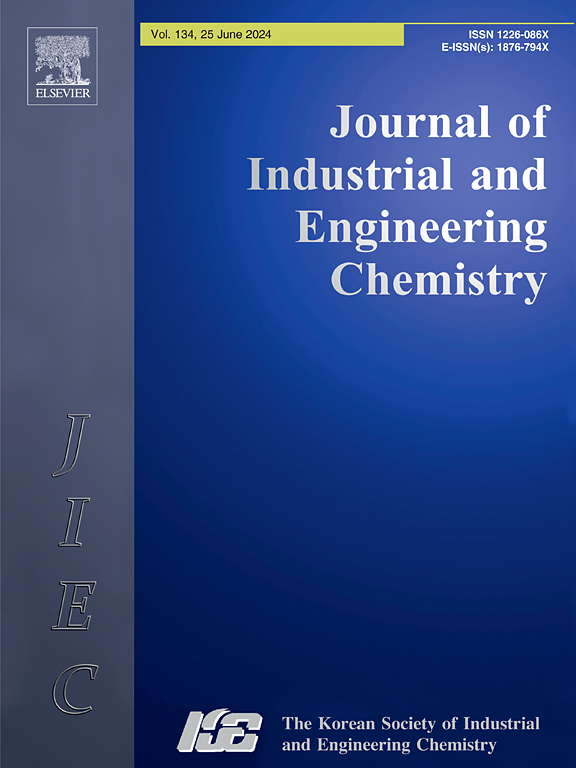Enhanced copper-adsorption removal from water by easy-handling silica aerogel-polyurethane foam composites
IF 5.9
3区 工程技术
Q1 CHEMISTRY, MULTIDISCIPLINARY
Journal of Industrial and Engineering Chemistry
Pub Date : 2024-11-24
DOI:10.1016/j.jiec.2024.11.041
引用次数: 0
Abstract
Safe water supply has become one of the main concerns of our society due to the intense industrial activities generating hazardous waste. Among the water pollutants, copper ions are known for potential diseases caused by accumulation of this metal. Therefore, different adsorbents have been produced for this purpose, highlighting aerogels for their effective adsorption owing to their high surface areas and porosity. Herein the synthesis of a novel silica aerogel-based composite for copper removal is described. It was produced by the sol–gel technique, synthesizing the silica aerogel into a reticulated-polyurethane foam that acted as a macrocellular skeleton, preventing a strong shrinkage of the aerogel during the ambient pressure drying. The produced aerogels and composites were characterized in terms of density, textural properties, hydrophobicity, and copper removal efficiency. Isotherm studies revealed a significantly improved adsorption capacity in comparison with the monolithic aerogel, reaching a maximum value of 46.13 mg g−1. The predominant adsorption mechanism was Langmuir- Freundlich adsorption. The adsorption kinetics were also evaluated by different models, as well as the ability to function as filtration medium. Therefore, this work provides a promising strategy for copper uptake avoiding tedious filtration steps to separate the adsorbent, thus reducing time and costs.

通过易于处理的二氧化硅气凝胶-聚氨酯泡沫复合材料增强对水中铜的吸附去除
由于大量的工业活动产生有害废物,安全供水已成为我们社会关注的主要问题之一。在水污染物中,铜离子被认为是由这种金属积累引起的潜在疾病。因此,不同的吸附剂为此目的而产生,突出气凝胶由于其高表面积和孔隙率而有效吸附。本文描述了一种新型二氧化硅气凝胶基除铜复合材料的合成。它是通过溶胶-凝胶技术生产的,将二氧化硅气凝胶合成成网状聚氨酯泡沫,作为大细胞骨架,防止气凝胶在环境压力干燥过程中强烈收缩。对制备的气凝胶和复合材料进行了密度、结构性能、疏水性和除铜效率等方面的表征。等温线研究表明,与整体气凝胶相比,吸附量显著提高,达到最大值46.13 mg g−1。吸附机理以Langmuir- Freundlich吸附为主。通过不同的模型对其吸附动力学进行了评价,并对其作为过滤介质的能力进行了评价。因此,这项工作为铜的吸收提供了一种有前途的策略,避免了繁琐的过滤步骤来分离吸附剂,从而减少了时间和成本。
本文章由计算机程序翻译,如有差异,请以英文原文为准。
求助全文
约1分钟内获得全文
求助全文
来源期刊
CiteScore
10.40
自引率
6.60%
发文量
639
审稿时长
29 days
期刊介绍:
Journal of Industrial and Engineering Chemistry is published monthly in English by the Korean Society of Industrial and Engineering Chemistry. JIEC brings together multidisciplinary interests in one journal and is to disseminate information on all aspects of research and development in industrial and engineering chemistry. Contributions in the form of research articles, short communications, notes and reviews are considered for publication. The editors welcome original contributions that have not been and are not to be published elsewhere. Instruction to authors and a manuscript submissions form are printed at the end of each issue. Bulk reprints of individual articles can be ordered. This publication is partially supported by Korea Research Foundation and the Korean Federation of Science and Technology Societies.

 求助内容:
求助内容: 应助结果提醒方式:
应助结果提醒方式:


